

25 Things You Should Know About Plot. Previous iterations of the “25 Things” series: 25 Things Every Writer Should Know 25 Things You Should Know About Storytelling 25 Things You Should Know About Character And now… 1.
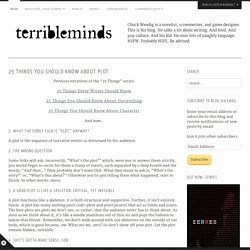
A plot is the sequence of narrative events as witnessed by the audience. 2. Some folks will ask, incorrectly, “What’s the plot?” Plotting. Unique Plots. TEN SIMPLE KEYS TO PLOT STRUCTURE. Structure is something that every agent and executive in Hollywood talks about, and that all of us teachers/authors/consultants/gurus/whatever go on and on about, to the point that it can seem complicated, intricate, mysterious and hard to master.
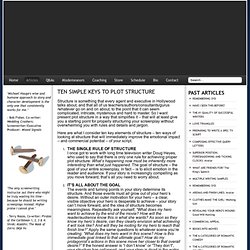
So I want present plot structure in a way that simplifies it – that will at least give you a starting point for properly structuring your screenplay without overwhelming you with rules and details and jargon. Here are what I consider ten key elements of structure – ten ways of looking at structure that will immediately improve the emotional impact – and commercial potential – of your script. THE SINGLE RULE OF STRUCTURE I once got to work with long time television writer Doug Heyes, who used to say that there is only one rule for achieving proper plot structure: What’s happening now must be inherently more interesting than what just happened.
Plotting Short Fiction. Last month at MRA, I listened to Jacqueline Woodson speak about her writing process.
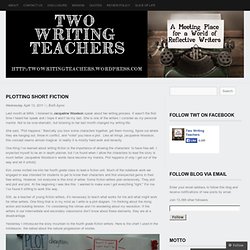
It wasn’t the first time I heard her speak and I hope it won’t be my last. She is one of the writers I consider as my personal mentor. Not to be over-dramatic, but listening to her last month changed my writing life. She said, “Plot happens.” Basically you toss some characters together, get them moving, figure out where they are hanging out, throw in conflict, and *voila* you have a plot. One thing I’ve learned about writing fiction is the importance of allowing the characters’ to have free will.
Kim Jones invited me into her fourth grade class to lead a fiction unit. Still, as a teacher of young fiction writers, it’s necessary to teach what works for me and what might work for other writers. Yesterday I introduced the story mountain to the fourth grade fiction writers. Then I gave them this planning sheet (click the link for a PDF). A few notes: Enemy Pie by D. Like this: Plot Development: How to write the climax and ending of your novel. By Glen C.

Strathy* Plot development is something you should think about after you have written a brief plot outline (Part 3). In this article, we're going to consider how to make sure the plot of your novel incorporates a satisfying climax and resolution. Many writers, especially pantsers, don't like to think about how their plot develops until they've written most of the first draft, preferring to let the ending evolve organically out of what comes before. Others may plan an ending ahead of time, but they prefer to rely on instinct, feeling, and a lot of trial and error rather than any kind of theory. I believe, however, that you can save yourself a lot of time and effort in the long run by making a few decisions about how your plot develops and the nature of your story early on. Of course, your ending must make emotional and logical sense.
Will Your Novel End Happily, Unhappily, Or Somewhere In Between? If the answer is no, then in classical terms, your novel will be a tragedy. 1. 2. 3. How to Build Subplots From Multiple Viewpoints. Multiple viewpoints provide diversion from, and contrast to, the protagonist’s perspective.

They can deepen conflict, enlarge a story’s scope and add to a novel the rich texture of real life. Subplots carry those effects even further. In our workaday world, we do not live in isolation. Our lives intersect, collide and overlap. Subplots lend the same sense of connectivity to a novel. Subplots and multiple points of view are often linked by their very natures. Plotting Made Simple. The Seven Basic Plots. The Seven Basic Plots: Why We Tell Stories is a 2004 book by Christopher Booker, a Jungian-influenced analysis of stories and their psychological meaning.
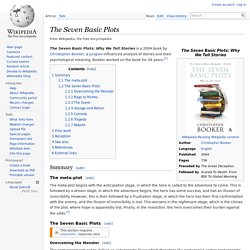
Booker worked on the book for 34 years.[1] Summary[edit] [edit] The meta-plot begins with the anticipation stage, in which the hero is called to the adventure to come. This is followed by a dream stage, in which the adventure begins, the hero has some success, and has an illusion of invincibility. The Seven Basic Plots[edit] Overcoming the Monster[edit] The protagonist sets out to defeat an antagonistic force which threatens the protagonist and/or protagonist's homeland. » Blog Archive » Plotting Your Novel – The Quick Outline Tool. Nothing draws a line in the sand of novel writing like the question, “To outline or not to outline.”
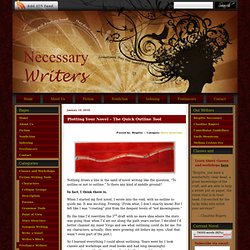
Is there any kind of middle ground? In fact, I think there is. When I started my first novel, I wrote into the void, with no outline to guide me. It was exciting.